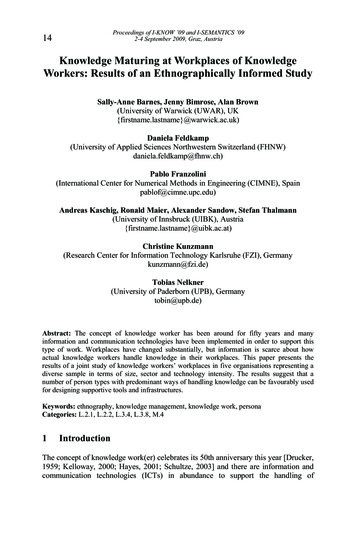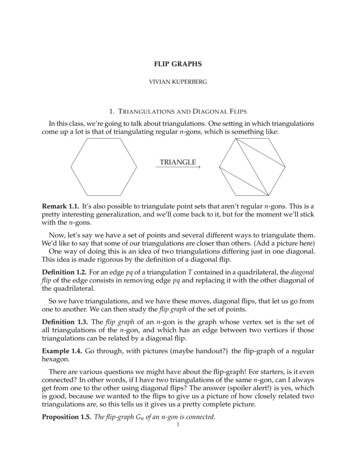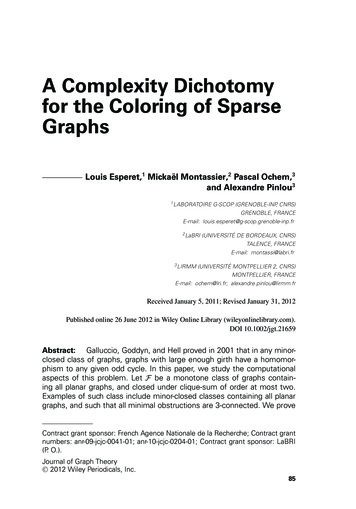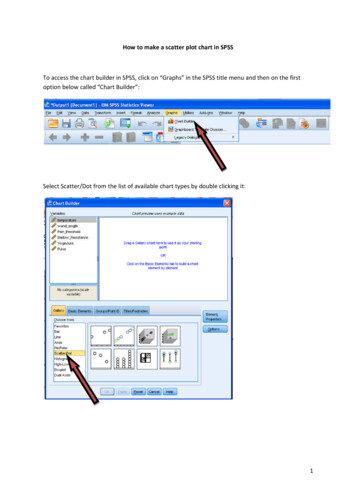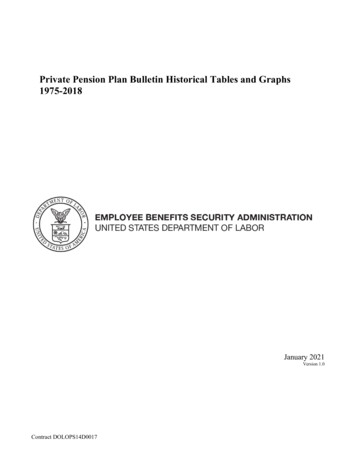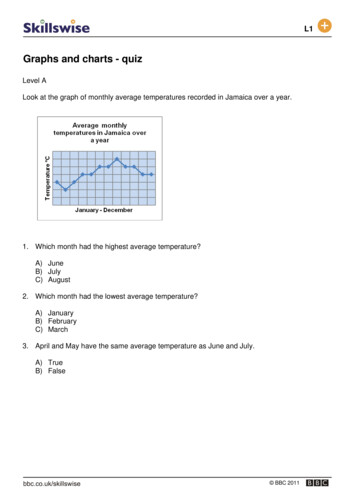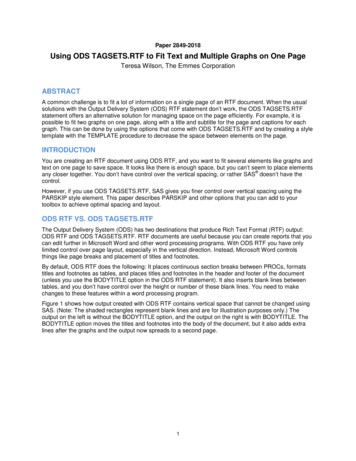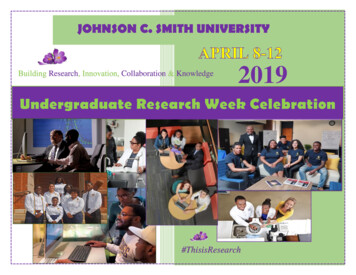
Transcription
Building Knowledge Graphs from Survey Data:A Use Case in the Social SciencesLars Heling1 , Felix Bensmann2 , Benjamin Zapilko2 ,Maribel Acosta1 , and York Sure-Vetter11Institute AIFB, Karlsruhe Institute of Technology (KIT), Karlsruhe, Germanyfirstname.lastname@kit.edu2GESIS - Leibniz Institute for the Social Sciences, Cologne, Germanyfirstname.lastname@gesis.orgAbstract. Many research endeavors in the social sciences rely on highquality empirical data. Survey data is often used to investigate social andpolitical behavior. The GESIS Panel is a probability-based mixed-modepanel survey in Germany providing high-quality survey and statisticaldata about e.g. political opinions, well-being, and other contemporarysocietal topics. In general, the process for integrating and analyzing therelevant data is very time-consuming for researchers. This is due to thefact, that search, discovery, and retrieval of the survey data require accessing various data sources providing different information in differentfile formats. In this paper, we present our architecture for building aKnowledge Graph of the GESIS Panel data. We present the relevantheterogeneous data sources and demonstrate how we semantically liftand interlink the data in a shared RDF model. At the core of our architecture is the Knowledge Graph representing all aspects of the surveys.It is generated in a modular fashion and therefore, our solution can betransferred to the existing infrastructure of other survey data publishers.Keywords: Knowledge Graph, Survey Data, RDF, DDI1Introduction and MotivationLinked Open Data initiatives have led to an increasing amount of data beingpublished using the Resource Description Framework (RDF) on the web. At thecore of RDF is the concept of linking resources within or across RDF graphssuch that the resulting dataspace can be understood as a Knowledge Graph(KG) [7]. This allows data publishers to independently administer and publishtheir own data and improving its value and visibility by linking it to data ofother publishers offering similar or additional information on the resources. Inthis paper, we present an in-use application of such a KG in the domain of thesocial sciences at GESIS - Leibniz Institute for the Social Sciences. Our workis motivated by the circumstance that data related to the GESIS Panel3 likec 2019 for this paper by its authors. Use permitted under Creative ComCopyright mons License Attribution 4.0 International (CC BY anel-home/
2Heling, Bensmann, Zapilko, Acosta, Sure-VetterKeyword-basedSearch PotentialStudiesCodebookPDFsRelevantVariables ObservationsFig. 1: Motivation: Current process to retrieve survey data based on a hypothesis.questionnaires and observation data is administered and published in differentdatasets varying in format and representation. As a result, the current processfor researchers aiming to use the rich collection of surveys available at GESISrequires manually consulting different information sources to discover and obtainrelevant data which is a time-consuming task.Motivating Scenario. Consider the current process to discover and retrievethe data from the GESIS Panel outlined in Figure 1. A researcher has a researchquestion and formulates a hypothesis according to which she aims to investigateby leveraging the data provided by the GESIS Panel. Typically, the researcherfirst starts to discover the available survey datasets by a keyword-based searchin the Data Catalog (DBK)4 , which is the online portal to search and retrievesurvey related data. The search results are a list of surveys which match thekeyword on the survey-level metadata, e.g. in the abstract summarizing thesurvey. Based on this list, the researcher can retrieve the codebook PDFs for allsurveys from the portal. In the codebooks, the variables assessed in the surveysare detailed, and the researcher may search for all relevant variables. To obtainthe final analysis dataset, the researcher needs to access the CSV documents withthe recorded participant answers (or observations) for the relevant variables. Insome cases, a download from the DBK is not available because of data protectionlaws and researchers are required to physically visit the Secure Data Center SafeRoom at GESIS to access and work with the data on-site. After retrieving thefinal dataset, the researcher may use statistical analysis tools to investigate thehypothesis. This tedious process from a hypothesis to gaining first insights intothe actual data impedes the research process for social scientists.The goal of building a KG for the survey data is improving this process forresearchers by facilitating the discovery and retrieval of relevant data. UsingSemantic Web technologies as a foundation allows for publishing and linkingdata of independent sources providing a holistic picture of the GESIS Panel inthe form a KG. Therefore, the contributions of this work are the following:C1 Description and analysis of a real world scenario from the social sciencesdomain with corresponding requirements,C2 Outline of our solution to handle data organization requirements by applying Semantic Web technologies to create a Knowledge Graph, andC3 Presentation of encountered challenges, lessons learned, and indicationof future extensions.4https://dbk.gesis.org/dbksearch/
Building Knowledge Graphs from Survey Data3In addition, we provide a demo5 allowing access to parts of the KG. The remainder of this paper is structured as follows. In Section 2, we provide thepreliminaries by introducing the GESIS Panel and relevant vocabularies, i.e.,the DDI and the DDI-RDF Discovery Vocabulary. In Section 3, we present thearchitecture of our approach. We then revisit our motivating scenario and outlinechallenges encountered and lessons learned in Section 4 and analyze related workin Section 5. We summarize our work in Section 6 and indicate future works.2PreliminariesIn the following, we introduce the GESIS Panel, the Data Documentation Initiative (DDI) and the corresponding DDI-RDF Discovery Vocabulary.2.1GESIS PanelThe GESIS Panel3 is a probability-based mixed-mode panel survey in Germany which is open to the research community [3]. The goal is obtaining highquality survey data by employing a cross-sectional or longitudinal survey design.Probability-based indicates a participant selection optimized to accurately estimating the target population, which are German-speaking persons between age18 and 70 who live in private households in Germany. Mixed-mode refers to thetwo modes of the data collection process, namely via web-based surveys or viatraditional paper-and-pencil surveys sent to the participants. The data collectionis performed periodically in waves on a bimonthly basis with a new questionnairein each period, producing a continuously growing dataset. The data is publishedin three editions: standard edition, extended edition and campus file, each covering different subsets of the recorded data. Standard edition and campus file canbe retrieved online, while the extended edition may only be accessed within theaforementioned Safe Room. The data collected in the GESIS Panel may serve asa basis for analyses in the social sciences and it has been used in several studies,for example, to examine the political opinions of the German population [4,6].2.2DDI and DDI-RDF Discovery VocabularyThe Data Documentation Initiative (DDI)6 is an internationally acknowledgedstandard to facilitate data management by documenting metadata on the datasetsin the area of social, behavioral and economic sciences [9]. Therefore, the standard aims to improve data quality and ensure the long-term preservation of theinformation and it is driven by an alliance of data producers, archivists and usersto jointly collaborate on the standard [9]. The DDI-RDF Discovery Vocabulary7(disco) aims at transferring the DDI standard to the Linked Data cabulary.ddialliance.org/discovery.html6
4Heling, Bensmann, Zapilko, Acosta, Sure-VetterIt is based on a subset of DDI allowing for describing survey data in the socialsciences which facilitates the discovery of this data and related metadata [1,2].At the core of the vocabulary is the Study class which represents the generation process of a dataset. A set of studies is compiled in a StudyGroup in casethe surveys are conducted in a continuous or periodic process. For example, eachwave of the GESIS Panel can be modeled as a Study and they are combined intoone StudyGroup. The content of the physical dataset holding the actual originalsurvey data is represented in a LogicalDataSet for which licensing informationand access policies may be attached. The content of a dataset is described byVariables. Variables represent different aspects which are measured as part of aStudy and, thus, are typically the columns in a tabular representation of the survey records. The data of a survey is commonly collected using a Questionnairewhich consists of a set of Questions to measure the variables. Variables are associated with a Representation which is typically the set of answers for theassociated question and the corresponding notation used in the dataset. TheRepresentation is linked as the responseDomain to a question. Furthermore,the target population of a Study may be described using the classes Universeand AnalysisUnit. For instance, the target population of the GESIS Panel is arepresentative sample of the German population and, thus, the analysis unit ispersons. The development of an RDF vocabulary along with the already existingDDI standard is motivated by various use cases which mostly support the discoverability of the data [1,11]. For instance, free text keyword-based search maybe enabled and once studies and relevant data has been found, related studiesand additional data may be discovered exploiting the links across the datasets.3Building a Knowledge Graph for the GESIS PanelThe goal of building a Knowledge Graph (KG) for the GESIS Panel by semantically lifting the original data sources to a shared RDF data model is improvingthe discovery, search and retrieval of survey data for social scientists. In the following, we provide an overview of the architecture and thereafter, describe theoriginal data sources as well as the semantic lifting process in more detail.3.1ArchitectureFigure 2 provides an overview of our architecture and the main components.From an integration perspective, the integration process is visualized in a bottomup manner. At the bottom are the data sources providing different parts of dataassociated with the GESIS Panel:i) the access right management data associated with the datasets, ii) the survey metadata providing general informationabout surveys and corresponding waves, iii) the codebooks with informationon how the variables in a survey are to be interpreted, and iv) the participantobservations (unit-records) which encode the respondents’ answers to the questionnaires. The data sources vary in format and schema. Therefore, each datasource requires a custom semantic lifting process to transfer the original data to
Building Knowledge Graphs from Survey DataFederated Query IS Panel Knowledge GraphAccess GraphSurvey DataRDF GraphsSemanticLifting Processi)Access aFig. 2: Architecture of the infrastructure for building the GESIS Panel KG.the shared RDF data model. Since the data sources are heterogeneous in natureand their maintenance is deeply rooted in and grown together with the organization of GESIS, the lifting processes need to be invoked individually, wheneverupdates on a specific dataset are to be made. Each semantic lifting process takesan original data set as input and returns an RDF graph. By defining conventions for naming resources (URIs) of common instances across the different datasources, they are interlinked across the RDF graphs. As a result, each graphstands for itself but combined together they provide a holistic KG of the GESISPanel. In our implementation, each graph is provided via an individual SPARQLendpoint as this allows for the original data providers to independently manageand publish their data. Furthermore, survey metadata and codebook data maybe offered via public endpoints to allow researchers to discover available datawhile parts of the participant observations may only be accessed within the SafeRoom to comply to data security and privacy regulations of GESIS. Finally, atthe top is the integration layer consisting of SPARQL endpoints which may beaccessed by a federated engine to query the KG. The integration layer may bedirectly queried by users or, alternatively, accessed by an application such as aGUI. In our specific case, the non-sensitive data may be merged and providedby a single endpoint for performance improvements when querying the data.Here we present the generic architecture as this may not be applicable in anyorganization. According to this bottom-up architecture and existing processesat GESIS, changes in individual data sources are propagated from the originaldata to the KG via a semantic lifting process.3.2GESIS Panel Knowledge GraphWe provide a simplified example extract of the GESIS Panel KG in Figure 3to exemplifying the RDF graphs from the different data sources and how theyare interlinked. Thereafter, we detail the semantic lifting process. Starting at
6Heling, Bensmann, Zapilko, Acosta, Sure-Vetterthe top, Figure 3a shows user User1 and a RightStatement to indicate theuser’s permissions to access the extended edition of GESIS Panel data. ThisRightStatement is linked to the metadata for the survey WaveA as shown inFigure 3b. The figure shows a subset of the original metadata that includes theLogicalDataSet providing the data, title, subjects, variables of the wave, as wellas the time period in which the wave was conducted. In the example, merely thevariable Gender is shown for the wave. The variable is linked to the questionnairecodebook subgraph shown in Figure 3c which provides details for the variablesuch as the question text and corresponding answers as well as their notation.Moreover, each variable has a corresponding property which is used in the participant observation subgraph. Figure 3d shows the recorded data for a participantrepresented using the RDF Data Cube Vocabulary8 . Each observation is a blanknode linked to the participant’s identifier and the recorded variable values usingthe corresponding properties. In the example, the participant is male accordingto the notation provided in the questionnaire codebook.3.3Original Data and Semantic LiftingIn the following, we describe the original data available at GESIS and detail howthe data is semantically lifted to the shared RDF data model of our KG.Access Right Management. Considering the access policies, there are threedifferent editions of the GESIS Panel: campus file, standard edition, and extended edition. In each edition, a different subset of survey data and variablesare available. Accordingly, the access rights need to be defined on this level. TheDublin Core vocabulary (dcterms), which is reused in the disco vocabulary,allows for defining such access right statements on the level LogicalDataSetsand the data is associated with the corresponding access rights according to theedition. Furthermore, a user model is employed to define users and link them tothe access right statements. Currently, this process is implemented in a manualfashion, however, we aim to integrate the access right management for our KGto existing solutions, such as the Lighweight Direcory Access Protocol (LDAP).Survey Metadata. The Data Catalog (DBK)4 is the online portal provided byGESIS to search and retrieve survey data including the GESIS Panel. The DBKoperates on metadata describing surveys as a whole but not on the level of individual variables. Important aspects in the metadata are, for instance, citationdata, version information, date of collection, or methodology. The survey-levelmetadata may also be retrieved from an internal database as XML documentsfollowing the DDI standard, where the data is continuously updated in an automatic fashion. As the GESIS Panel is considered as a single evergrowing survey,it is represented in a single large DDI file comprising the information of all associated waves. However, each time a wave is added, a new version is createdfor researchers to keep track of data provenance. We choose to represent thesurvey on the level of waves as individual Studys to allow for a consistent andretraceable mapping to the corresponding concepts of the disco vocabulary.8https://www.w3.org/TR/vocab-data-cube/
Building Knowledge Graphs from Survey Data7(a) Access Right ss to the Gesis Panel Extended Edition.''@en(b) Survey EditionAccessRightsdisco:startDate''2017-04-19'' xsd:date''Wave -13'' riablesubject:WaveA-44skos:prefLabel''Political Interest''@envariable:Gender(c) Questionnaire Codebook''1'' os:inSchemeskos:notation''0'' kos:prefLabel''Gender of :NotInitedskos:notation''-1'' xsd:integerprop:genderrdf:typerdf:Property(d) Participant Observationprop:genderrdf:type:observation1''1'' rticipant''6'' xsd:integerparticipants:123456Fig. 3: Knowledge Graph Extract: The figures visualize the subgraphs of theKnowledge Graph to provide an overview of the shared RDF data model andthe interlinking between the data sources. The dashed arrows indicate these relationships between shared resources. (The prefixes for dcterms, disco, foaf,rdf, skos and qb are used as in prefix.cc. The sora prefix is used forour vocabulary9 . The other prefixes adhere to the scheme http://./gesis/resource/ prefix /.)
8Heling, Bensmann, Zapilko, Acosta, Sure-VetterTable 1: Questionnaire Codebook: Simplified example extract of the codebookfor a variable assessing a participant’s gender measured in two surveys.varname labelEn derGender.GenderGenderGender.of the respondentof the respondentof the respondentcode valueLabel waveID betweenCorrespondence . . .-101.of the respondent -1of the respondent 0of the respondent 1.Not InitedFemaleMale.Not enderBgenderBgenderB.Questionnaire Codebook. The detailed information on the variables and thecorresponding questionnaires for each wave are provided in codebooks. For researchers, the codebooks are accessible as PDF files in the DBK portal. Internally, these PDFs are generated from CSV files containing all the necessaryinformation in a tabular format. The data for the example extract is shown inTable 1. Variables are uniquely identified by a varname which is based on theidentifier of the corresponding wave (i.e., waveID) and a number (omitted forvisualization purposes). Variables are represented in the rows and depending onthe type of question and set of answers, several rows represent a single variable.This t
3 Building a Knowledge Graph for the GESIS Panel The goal of building a Knowledge Graph (KG) for the GESIS Panel by semanti-cally lifting the original data sources to a shared RDF data model is improving the discovery, search and retrieval of survey data for social scientists. In the fol-Author: Lars Heling, Felix Bensmann, Benjamin Zapilko, Maribel Acosta, York Sure-Vetter

